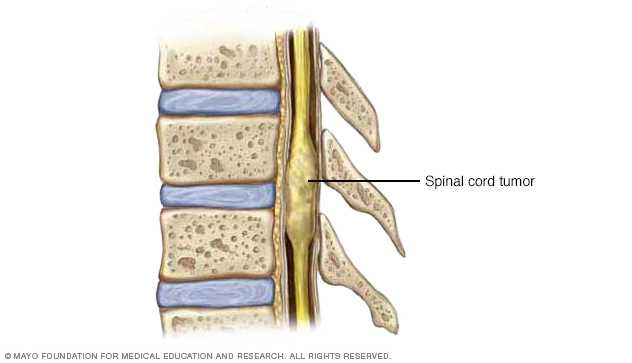

They may include but are not limited to: Back pain and neck pain, which are the most common symptoms of spinal tumors. As the disease progresses, spinal cancer symptoms may grow to include weakness, inability to move the legs and, eventually, paralysis. Symptoms of spinal cancer and spinal tumors may vary depending on the tumor type and location. Next, patients may experience clumsiness, not knowing where their feet are, and difficulty with buttons or keys. When the tumor presses on the spinal cord, symptoms may begin with numbness or tingling in the arms or legs. When the spine is not lined up properly, other physically notable symptoms may result (e.g., changes in posture, Kyphosis or hunchback). If you are diagnosed with a brain tumor, make sure your provider helps you understand where it is located. As your tumor grows, it can press on surrounding tissue, affecting the function controlled by that part of the brain. Pain may come from the tumor's presence in the spinal column, pushing on sensitive nerve endings or causing spinal instability. The symptoms you are experiencing are linked to the location of the tumor in your brain.

The most noticeable sign of spinal cancer is pain. Metastatic spinal tumors, which have spread to the spine from another location in the body, such as the prostate or kidneys, often progress quickly. Other times, they occur quickly, even over a matter of hours or days. The symptoms of spinal cancer may occur very slowly. Some common spinal cancer symptoms include pain, numbness, weakness and difficulty with urination. This may include if you are experiencing a seizure that lasts longer than five minutes or when you have multiple seizures that occur close together and you do not recover between seizures.The symptoms of spinal cancer depend on several factors, including the tumor type, size, location, as well as age and health history of the patient. Report if your seizure gets worse, if your seizure is severe (>7), or your seizures do not improve from your self-care activities.Īsk your doctor what you should do in the case of an emergency and when your seizures should be reported urgently.
Tumor on spine symptoms how to#
Ask your doctor when and how to report your symptoms to them. Share your logged symptoms and self-care activities with them. Missed and altering medications is one of the most common causes of seizures.Ĭonnect with your health care provider and discuss any concerns you have. Talk with your health care team if you miss a dose and avoid suddenly stopping any medication. It may impact the medications ability to work. Review if you should take seizure medication with food or avoid food when taking. Take your medication exactly as prescribed. If your medications do not work as expected, your medication may also need to be adjusted. Spinal cord compression (eg, cervical myelopathy) may cause different neurological. Ask your health care provider what medication they want you to take for seizure prevention and what other pain medication you should take after a seizure occurs. In addition to pain, metastatic spinal tumors can compress your spinal cord. If you have experienced seizures or are at risk, ask for their recommendations and limitations for you (for example, you should not swim alone). Overheating and rapid breathing are triggers for seizures. Start slow and don’t push yourself too hard. Talk to your doctor about restarting your exercise plan to see what exercises would be right for you. If a seizure has occurred, you may have changes in your strength or balance. Avoid alcohol as this can cause you to have seizures. Some self-care activities you can do to improve your pain can include diet, exercise, sleep, or medication. Triggers may include: missing or taking your anti-seizure medication late, stress, lack of sleep, other illnesses or infections, overheating or overexertion, alcohol intake, flashing lights, and for women, their menstrual cycle. Recognize and avoid triggers, which are things that may lead to seizures or make them more severe or frequent. After the seizure you may be sleepy and feel like you will vomit, so you or someone with you should place you on your left side to help with this. Monitor how long the seizure lasts and parts of the body involved. Ask your health care provider when you should alert a designated emergency contact (for example, 911). Get to a safe place on the floor or ground and alert someone that the seizure has started. Develop a seizure emergency plan with your doctors and include those living with you so you know what to do and who to call. What happened after the seizure stopped?. What type of seizure did you have (focal or generalized)?. What part of the body was involved and how long did the seizure last?. What, if any, symptoms you had prior to the seizure?. What you were doing before the seizure occurred?. Record if you have a seizure and what you are doing to manage it daily using a journal. View and Print Infographic Ways to Manage Seizures






 0 kommentar(er)
0 kommentar(er)
